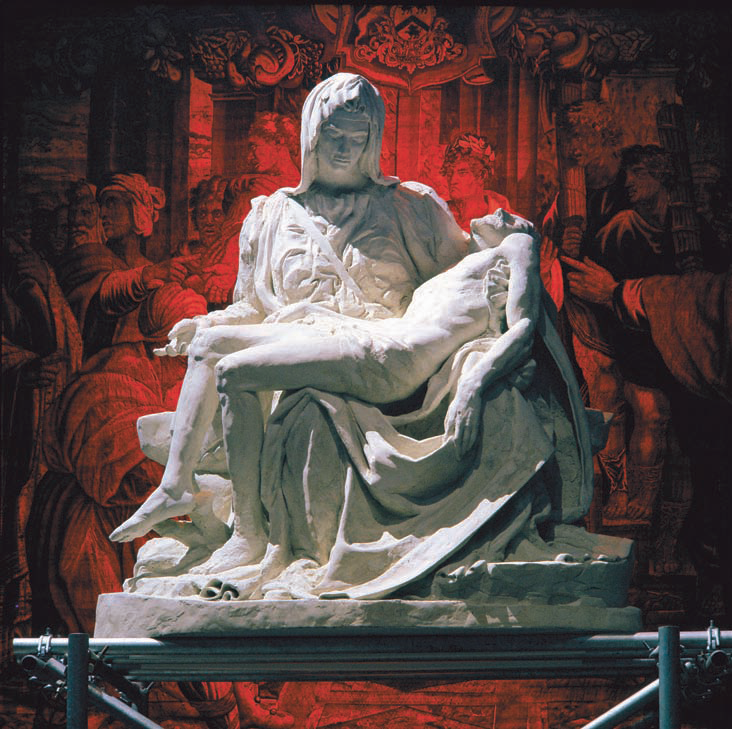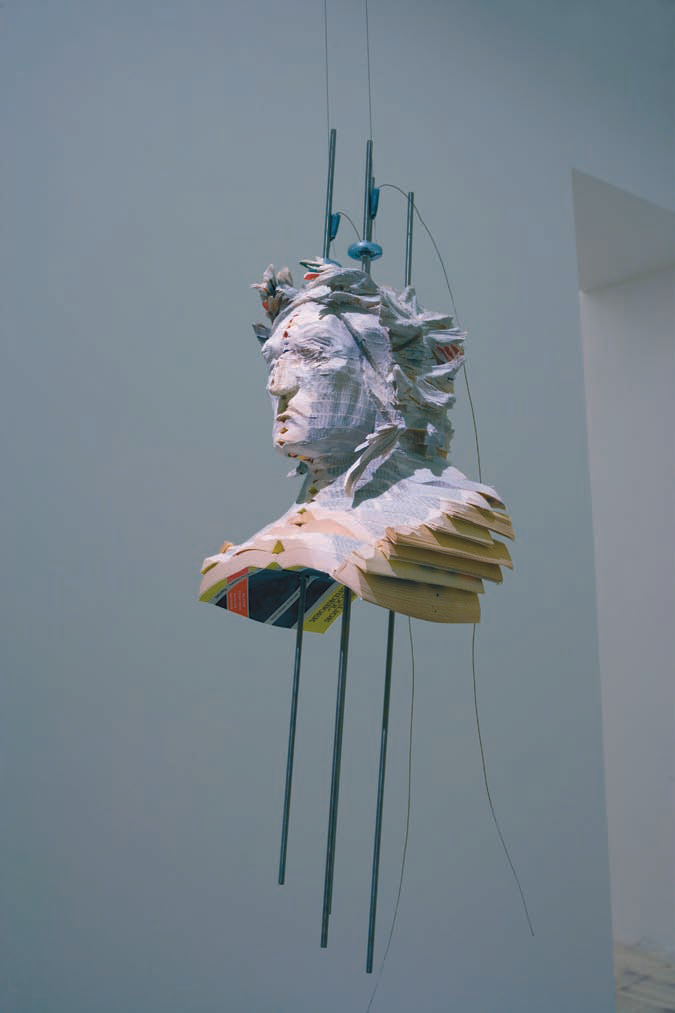In a seminal postliberation South African work, titled Commune: Suspension of Disbelief (2001), Johannesburg-based artist Wim Botha carved a crossless crucified Christ from stacks of Bibles bolted together with a threaded bar. Despite the work’s obvious iconoclasm, it had deeper layers of meaning. Catholicism distinguishes itself from other strains of Christianity chiefly through its insistence on transubstantiation, the central belief that the wafer and wine in the Eucharist ceremony actually become the Body and Blood of Christ. In religion, as for creative endeavors, the notion of transubstantiation holds far more compelling possibilities than mere symbolism ever could.
Lassoing the notion of transubstantiation, Botha’s Commune becomes an aesthetic take on the phrase “the Word made flesh.” Language is present yet muted in this work; the medium through which the Christian message is communicated, the printed Bible page, becomes the base unit for the sculpture. One form of existence gives way for another, as a very real transmutation takes place.
Botha takes this idea a step further by setting up closed-circuit television cameras trained on the sculpture, progressively defocusing and cropping the images. In their now visually abstract state and thus drained of content, these images are shown on monitors elsewhere in the space. The subversion of the Christian imperative of “the Word made flesh” is patent.
In a similar way, Botha’s work Mieliepap Pietà (2004) switches the very stuff of Michelangelo’s original, hallowed marble for maize meal mixed with epoxy resin. Maize is a staple food for much of South Africa’s lower working class, and in Botha’s work, the Pietà embodies the agony of deprivation in the wake of decades of social and political inequality.
Significantly, Botha’s Pietà is not a direct copy of the original but a precise mirror image, a reversed reflection. Presented as it was at St. John the Divine Cathedral in New York for the 2004 Personal Affects exhibition, it became a strange order of doppelganger. The work represents a quietly anarchic achievement, a subtly yet crucially altered version of one of Catholicism’s most revered works.
Botha reinterprets other classic works to fit a local context. Botticelli’s Portrait of Dante (1495) reemerges as Generic Self-Portrait as an Exile (2008), reflecting upon Dante’s thwarted desire to return gloriously from political exile. Again, books—this time, learners’ dictionaries in four local languages (a nod to the “Self-Portrait” in the title)—have been bolted together to make a carving block from which Dante’s beaky face and a laurel wreath emerge in sharply cut planes. The incised pages preclude any attempt at linguistic cross-pollination.
Comments art historian Liese van der Watt on the artist’s work in general, “It is this constant scrambling of givens, this interrogation of conventions that finally marks Botha’s practice as extraordinary.”

Commune: Suspension of Disbelief 2001
Carved Bibles and printed Bible paper, surveillance equipment
Installation views at the Klein Karoo National Arts Festival, Oudtshoorn
Collection:Johannesburg Art Gallery
Photographer: Wim Botha
© Wim Botha

Mieliepap Pietà (Maize Meal Pietà) 2004
Maize meal and resin
Dimensions identical to Michelangelo’s Pietà
174 x 195 cm
Image courtesy of Spier and the Michael Stevenson Gallery, Cape Town
Photographer: Mario Todeschini
© Wim Botha

Generic Self-portrait as an Exile 2008
Carved learner’s dictionaries (Afrikaans, English, isiZulu, seSotho)
46 x 32 x 27 cm
Image courtesy of the artist and the Michael Stevenson Gallery, Cape Town
Photographer: Mario Todeschini
© Wim Botha